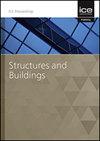Blast resistance of RC columns for varied detonation scenarios: Effect of shear detailing
IF 1.4
4区 工程技术
Q3 CONSTRUCTION & BUILDING TECHNOLOGY
Proceedings of the Institution of Civil Engineers-Structures and Buildings
Pub Date : 2023-07-03
DOI:10.1680/jstbu.22.00205
引用次数: 0
Abstract
The growing threat of accidental and malevolent blast loading to building structures has necessitated the consideration of blast-resistant design. Columns are the most vulnerable and critical component of a building, so they must be designed against blast to achieve defined performance goals. The influence of transverse rebar detailing on the ultimate capacity and failure modes of rectangular reinforced concrete (RC) columns against blast loads was investigated under different detonation scenarios. The performance of the columns was quantified using the failure charge mass and post-blast residual axial capacity. Pressure–impulse diagrams were used to study the failure modes. The analyses showed that special transverse detailing measures were the most effective for columns subjected to near-field surface bursts. The confinement of concrete due to ties and axial restraint played a critical role in improving the blast performance of columns. The provision of diagonal rebar improved the blast resistance by preventing direct shear failure, and was most effective when coupled with closely spaced lateral ties. Finally, the performance of code-compliant columns against blast was studied to determine the blast safety margin and the scenarios under which it would be necessary to undertake blast retrofitting of the columns in existing critical buildings.不同爆轰情景下钢筋混凝土柱的抗爆性能:剪切细部的影响
随着意外爆炸和恶性爆炸荷载对建筑结构的威胁日益严重,建筑结构必须考虑防爆设计。柱子是建筑物中最脆弱和最关键的组成部分,因此它们必须设计成抗爆炸的,以达到规定的性能目标。研究了不同爆轰工况下横截面配筋对矩形钢筋混凝土柱抗爆炸荷载极限承载力和破坏模式的影响。采用破坏装药质量和爆破后残余轴向承载力对柱的性能进行了量化。采用压力-冲量图对失效模式进行了研究。分析表明,特殊的横向细部措施对近场地表爆震柱最有效。混凝土的约束和轴向约束对提高柱的爆破性能起着至关重要的作用。斜向钢筋通过防止直接剪切破坏来提高抗爆破能力,并且当与紧密间隔的横向连接相结合时最有效。最后,对符合规范的柱抗爆破性能进行了研究,以确定爆炸安全裕度以及在何种情况下需要对现有关键建筑中的柱进行爆破改造。
本文章由计算机程序翻译,如有差异,请以英文原文为准。
求助全文
约1分钟内获得全文
求助全文
来源期刊
CiteScore
3.40
自引率
6.20%
发文量
61
审稿时长
12 months
期刊介绍:
Structures and Buildings publishes peer-reviewed papers on the design and construction of civil engineering structures and the applied research associated with such activities. Topics include the design, strength, durability and behaviour of structural components and systems.
Topics covered: energy conservation, people movement within and around buildings, strength and durability of steel and concrete structural components, and the behaviour of building and bridge components and systems

 求助内容:
求助内容: 应助结果提醒方式:
应助结果提醒方式:


